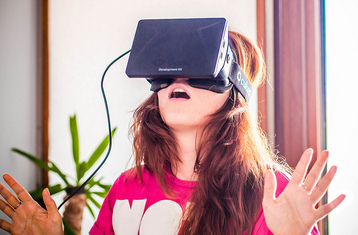Is Oculus Rift Virtual Reality Headset a Hint of the Future?

In a word, yes, and if the recently announced $2 billion Facebook acquisition of Oculus Rift is any indication, then hell yes! Virtual Reality has long been that gray area between science fiction and reality; it looked very futuristic, and it was also a technology that was commercially available.
However being costly and still not quite there yet (low res displays, poor field of view and lack of total immersion) meant that it never gained any traction.
(Sergey Galyonkin / Flickr / CC-BY-SA)
Oculus Rift is being designed to address ALL of the issues that other headsets couldn’t overcome – it will be affordable, offers HD resolution and a respectable field of view lending an extremely immersive experience (if the independent developer reviews are to be believed).
While the Rift was solely being developed for gaming, such technology, when made cheap and accessible has the potential to change a lot of other things as well; imagine going to a virtual movie theater wearing your Rift and enjoying the latest flick, online.
Or how about having a conference with every member of your team in a fantastic 3D room? You could also attend virtual sporting events wearing your Rift! Facebook’s interest and investment in this technology definitely point to such applications in times to come.
The technical nitty gritty of virtual reality
With conventional monitors, our immersion is limited to the resolution that can be displayed. However in virtual reality, resolution plays second fiddle to the Diagonal Field of View (dFOV). Since virtual reality headsets display a picture only inches away, the more your eye’s field of view is utilized, the better the immersion becomes.
The human eye’s field of view is 180 degrees; up till now, most virtual reality devices offered dFOV of 30 degrees to 45 degrees, which left a lot of viewing space wasted, leading to a tunnel vision type of experience. Most of them also only support resolutions up to 800X600 pixels, a far cry from what today’s monitors can crank out.
Finally, even these VR headsets are ridiculously hard to find and insanely expensive, with some of them costing as much as $10,000 per piece!
The Oculus Rift advantage
While the device is still under development, the consumer version is expected to offer a dFOV of 110 degrees which is more than twice as much as what is currently available. It will support resolution up to 1920X1080 pixels (Full HD) and will also have stereoscopic imaging (Real 3D).
The headset will have low latency head tracking, meaning when you turn your head, your view in the 3D environment will change correspondingly without any lag. Although its price has not been officially disclosed, sources close to the team developing the product are betting it will be below $500 per piece.
The Rift is currently available as a kit for developers at a price of $300 so that they can tune their software to utilize the hardware to the best of its abilities, and also report any bugs that might be there. If you are a developer with an interest in the subject, go over to www.oculusvr.com and order your unit today.
Remember! Most of the games and 3D software, today do not support the device so don’t order thinking you can just plug it in and start playing Counter-Strike right off the bat.
The first reports coming on to developer blogs who are tinkering with the Rift seem promising. Many of them are calling it the best visual aid device that could possibly exist! It has been well received by the IT community with many industry bigwigs wigs such as Gabe Newell of Valve Software and John Carmack of id Software endorsing the product and giving it their fullest support.
However being costly and still not quite there yet (low res displays, poor field of view and lack of total immersion) meant that it never gained any traction.
(Sergey Galyonkin / Flickr / CC-BY-SA)
Oculus Rift is being designed to address ALL of the issues that other headsets couldn’t overcome – it will be affordable, offers HD resolution and a respectable field of view lending an extremely immersive experience (if the independent developer reviews are to be believed).
While the Rift was solely being developed for gaming, such technology, when made cheap and accessible has the potential to change a lot of other things as well; imagine going to a virtual movie theater wearing your Rift and enjoying the latest flick, online.
Or how about having a conference with every member of your team in a fantastic 3D room? You could also attend virtual sporting events wearing your Rift! Facebook’s interest and investment in this technology definitely point to such applications in times to come.
The technical nitty gritty of virtual reality
With conventional monitors, our immersion is limited to the resolution that can be displayed. However in virtual reality, resolution plays second fiddle to the Diagonal Field of View (dFOV). Since virtual reality headsets display a picture only inches away, the more your eye’s field of view is utilized, the better the immersion becomes.
The human eye’s field of view is 180 degrees; up till now, most virtual reality devices offered dFOV of 30 degrees to 45 degrees, which left a lot of viewing space wasted, leading to a tunnel vision type of experience. Most of them also only support resolutions up to 800X600 pixels, a far cry from what today’s monitors can crank out.
Finally, even these VR headsets are ridiculously hard to find and insanely expensive, with some of them costing as much as $10,000 per piece!
The Oculus Rift advantage
While the device is still under development, the consumer version is expected to offer a dFOV of 110 degrees which is more than twice as much as what is currently available. It will support resolution up to 1920X1080 pixels (Full HD) and will also have stereoscopic imaging (Real 3D).
The headset will have low latency head tracking, meaning when you turn your head, your view in the 3D environment will change correspondingly without any lag. Although its price has not been officially disclosed, sources close to the team developing the product are betting it will be below $500 per piece.
The Rift is currently available as a kit for developers at a price of $300 so that they can tune their software to utilize the hardware to the best of its abilities, and also report any bugs that might be there. If you are a developer with an interest in the subject, go over to www.oculusvr.com and order your unit today.
Remember! Most of the games and 3D software, today do not support the device so don’t order thinking you can just plug it in and start playing Counter-Strike right off the bat.
The first reports coming on to developer blogs who are tinkering with the Rift seem promising. Many of them are calling it the best visual aid device that could possibly exist! It has been well received by the IT community with many industry bigwigs wigs such as Gabe Newell of Valve Software and John Carmack of id Software endorsing the product and giving it their fullest support.
